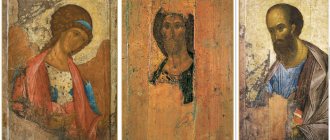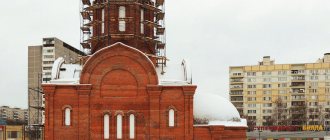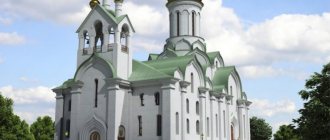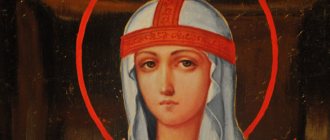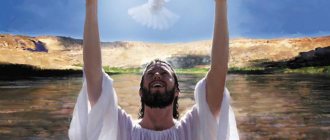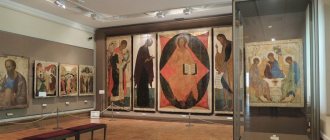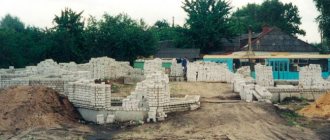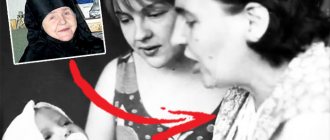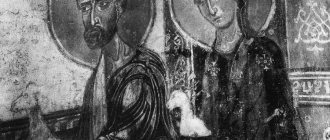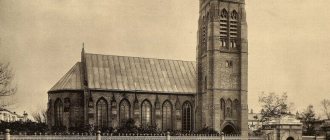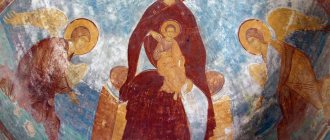| Rev. Andrei Rublev, icon. |
Andrei Rublev
(+ c. 1430), icon painter, disciple of Theophanes the Greek, Venerable Memory July 4, June 13 (together with his associates Venerables Andronik, Savva and Alexander, abbot of Moscow, and icon painter Daniil Cherny), January 29 (in the supposed day of repose; Greek [1]), in the Cathedrals of Moscow and Radonezh saints
At first he was a novice with St. Nikon of Radonezh, and then a monk in the Spaso-Andronikov Monastery in Moscow.
In the ancient life of St. Sergius of Radonezh, compiled by his disciple Epiphanius, decorated with numerous miniatures (16th century copy), Andrei Rublev is depicted in three forms: sitting on the stage and painting the image of the Savior Not Made by Hands on the wall of the temple; coming to the stone church newly built in the Lavra and being buried by the Lavra brethren.
He died, according to one of the assumptions, on January 29, 1430 in the Andronikov Monastery.
The largest works of Andrei Rublev are icons, as well as frescoes in the Cathedral of the Assumption in Vladimir (1408). The Deisis by Theophanes the Greek and Andrei Rublev, as well as the entire golden-domed Church of the Annunciation in the royal courtyard, near the royal treasury, burned down during a great fire in Moscow in 1547.
The greatest masters of ancient Russian painting, including Dionysius, were deeply influenced by his work. At the Stoglavy Cathedral (1551), Rublev’s icon painting was proclaimed a role model: it was directly ordered that “the painter should paint icons from ancient images, as the Greek painters wrote, and as Andrei Rublev and other notorious painters wrote.”
The great work done in the century to restore his works and clarify his artistic biography led to the formation of the romantic “Rublev legend”, which extracts the heroized figure of the artist from the anonymous, ascetic, supra-individual environment of medieval creativity.
A locally revered saint since the 16th century, he was canonized by the Russian Orthodox Church in 1988.
Biography of Andrei Rublev
The biography of Andrei Rublev contains few reliable facts. The exact date of Rublev’s birth is not known, and historians call the Principality of Moscow or Novgorod his place of birth. Andrei grew up in a family of icon painters. Later he became a monk, and then took the name Andrey.
Together with other masters, Rublev painted the Annunciation Cathedral, which was a confirmation of his skillful skill at that time. Also for his biography, Rublev painted the Trinity Cathedral and the Assumption Cathedral in the city of Vladimir.
But Rublev's greatest fame was as an icon painter. He created many icons, although icon painting was not traditional, in it he combined spiritual beauty and human strength.
Rublev’s most outstanding work is considered to be the “Life-Giving Trinity” icon, depicting three angels and a thicket in the center. Among Rublev’s other famous works are “The Apostle Paul”, “The Savior from the Zvenigorod Order”, the fresco “The Last Judgment” in the Assumption Cathedral.
Not all icons and frescoes have survived to this day.
The last work, if we consider the short biography of Andrei Rublev, was the painting in the Spassky Cathedral. The great master died in October 1428.
Popular message topics
- Leningrad About the Hero City The city of
Leningrad, now St. Petersburg, rightfully has a special degree of distinction in the USSR with the title of Hero City. The city on the Neva survived the terrible events of the Great Patriotic War. In 1941 The city was attacked by fascist invaders. There were no strength - Negative numbers
Negative numbers have not been recognized in science for several hundred years. This is due to the fact that negative numbers are something fictitious, unreal. Many years ago negative numbers were not recognized, - Plants of the Red Book
In order to better learn how to preserve and increase the plant and animal resources of nature, an exceptional collection has been created, which contains rare and endangered species of flora and fauna - the Red Book. Over the contents of the collection constantly
Rublev's creativity
Andrei Rublev adopted the traditions of classicism of Byzantine art of the 14th century, which he knew from the works of Greek masters who were in Moscow, and especially from the creations of Theophan the Greek of the Moscow period (Don Icon of the Mother of God, Icon of the Deesis in the Annunciation Cathedral).
Another important source of the formation of Andrei Rublev’s art is the painting of the Moscow school of the 14th century, with its soulful soulfulness and special softness of style, based on the traditions of Vladimir-Suzdal painting of the 12th - early 13th centuries.
The images of Andrei Rublev are generally adequate to the images of Byzantine art around 1400 and the first third of the 15th century, but differ from them in greater enlightenment, meekness and humility; they have nothing of the aristocratic nobility and intellectual dignity glorified by Byzantine art, but preference is given to modesty and simplicity.
The faces are Russian, with medium-sized features, without emphasized beauty, but always light and handsome.
Almost all the characters are immersed in a state of silent contemplation, which can be called “divine thinking” or “divine speculation”; any internal affects are not characteristic of them.
Angel symbol of the Evangelist Matthew
Apostle Paul
Evangelist Matthew
The work of Andrei Rublev determined the 15th century. the flourishing of the national school of Russian painting, original in relation to Byzantium. It had a huge influence on all Russian art of the Moscow circle right up to Dionysius.
Andrei Rublev - the great artist of ancient Rus'
The best of Andrei Rublev’s works is the miraculous icon of the Holy Trinity, now located in the State Tretyakov Gallery54.
The Klintsovsky icon-painting original reports that “Reverend Andrei, an icon painter of Radonezh, nicknamed Rublev, painted many holy icons, wonderfully beautiful and decorated; Andrei had previously lived in obedience to the venerable father Nikon of Radonezh: she commanded him to paint an image of the Most Holy Trinity with him in praise of his father Sergius the Wonderworker.”55 From this message we can, it seems, conclude that Andrei Rublev, called “Radonezhsky”, probably because of his original membership in the brethren of the Holy Trinity Monastery, founded by St. Sergius of Radonezh56, painted the icon of the Holy Trinity in the period of the full flowering of his talent - after that , as I have already written, “many holy icons are wonderful and decorated.” The words that previously “that Andrei lived in obedience to the Venerable Nikon” apparently have the nature of a casual remark, aimed at clarifying the image of the relationship between the abbot and the famous icon painter by indicating their former closeness. It must be assumed that by the time of painting the icon of the Holy Trinity, Rublev had already left the direct subordination of the monastery of St. Sergius, due to his position as a famous Moscow master, who was under the jurisdiction of the Grand Duke; “He was probably now listed as a monk of the Spaso-Andronikov Monastery near Moscow,”57 but, of course, he loved the monastery of St. Sergius as the place of his tonsure and long-term monastic labors under the spiritual guidance of St. Nikon. That the word “commanded” should not be understood as an order to the novice can, apparently, be concluded from a comparison of the testimony of the Klintsovsky original cited by us with the following chronicle instruction: “We need to remember this and that... as if the desire of the Reverend Father Abbot Nikon has been fulfilled. The elders and painters Danil and Andrei, who were named before him, beseeched him for the great virtues... and as if he decorated this church with a signature”58.
We are talking here about the invitation by the Monk Nikon of Daniil Cherny and Andrei Rublev to carry out the painting work of the white-stone Trinity Cathedral59, which began construction in 1422–1423, after the solemn opening of the relics of St. Sergius (formerly on July 5, 1422)60. It is most natural to assume that the painting of the icon of the Holy Trinity took place simultaneously with the painting of the Trinity Cathedral in general. D.S. Likhachev dates the painting of the icon of the Holy Trinity, as well as the invitation of St. Nikon Andrei Rublev and Daniil Cherny to paint frescoes and decorate the Trinity Cathedral in the Trinity-Sergius Monastery with icons, to 1424–1426.61 Yu.A. also thinks so. Lebedev62, disagreeing with the opinions of I.E. Grabar63 and V.I. Lazarev64, dating the painting of the icon of the Holy Trinity to 1411 or to an even earlier time65, when Andrei Rublev was in obedience to the Monk Nikon. It’s hard to guess, says Yu.A. Lebedev that the icon was painted in 1410–1411. for a small wooden church, erected after the invasion of the Tatar Khan Edigei, who burned all the buildings of the monastery.
It was usually believed that the icon of the Holy Trinity painted by Andrei Rublev was placed as the main local image in the first tier of the iconostasis of the Holy Trinity Cathedral on the right side of the royal doors66. However, V. Antonova convincingly proves that initially this icon was at the feet of the tomb of St. Sergius, serving as a kind of “altarpiece” in relation to the saint’s shrine; This is indicated, by the way, by the expression “in praise of... Sergius the Wonderworker”67.
In the 16th century a copy was made from the Rublev icon68. This new icon was covered with a golden robe by order of Ivan the Terrible and placed on the right side of the royal gates69.
In 1600, Boris Godunov decorated the Rublev icon with a golden chasuble with precious stones,70 as a result of which it was sometimes called “Godunovskaya”. Around 1626, it was moved to the place designated for the main temple icon,71 and a copy was placed in the second place to the left of the royal doors (immediately behind the Hodegetria icon of the Mother of God).
Most researchers of the 19th century. recognized the local icon (on the right side) as a work undoubtedly belonging to the brush of Andrei Rublev, and precisely the same one that was made at the request of the Monk Nikon “in praise of St. Sergius.” Only a few questioned this generally accepted version. So, for example, D.A. Rovinsky, who considered this icon to be the work of an ancient Italian artist, argued that, probably, only the news of the Klintsovsky original, repeated in the life of St. Sergius, “gave the occasion to I.M. Snegirev to attribute to Rublev the icon of the Holy Trinity, located in the Trinity Cathedral of the Sergius Lavra”72. However, Metropolitan of Moscow Filaret (Drozdov) considered it necessary to refute this opinion of D.A. Rovinsky, expressed by the latter in the 1850s, pointing out that “in the Sergius Lavra there is a constant tradition that this image was painted by Andrei Rublev under the Venerable Nikon”73. After Rovinsky, his doubts were repeated in a more restrained form by D.V. Ainalov and N. Sychev.
Brilliant proof of the truth of the tradition indicated by Metropolitan Philaret, and at the same time the justice of the universal conviction that the temple icon of the Trinity Cathedral belonged to the brush of Andrei Rublev, was provided by the work on the restoration of this icon.
In 1904, icon painter-restorer V.P. Guryanov, invited to carry out, under the supervision of the Moscow Archaeological Society, the restoration of all the icons of the Trinity Cathedral, with the permission of the Lavra authorities, cleared the “Godunov” icon from the upper layers74. Immediately after the clearing, a photograph was taken of the remaining original image75. A comparison of this photograph with the image before the clearing76 shows that quite significant changes were made by later icon painters; for example, the following were drawn: a) on the table - two branches of grapes, glasses and a plate; b) on the halos of angels - toroki (rumors)77; on the feet of angels are sandals; a rather modest tree has turned into a curly green oak (latest 19th century); in the angel on the far left, the standard78 was replaced by a staff with a cross at the end79.
“Although the icon,” writes I.E. Grabar, - was not completely cleaned up; in some places the 16th-century copybooks remained on it and new ones, already Guryanov’s, were added, but the impression that this first disclosure of Rublev’s painting made on the artistic and research circles of that time was truly amazing. Real pilgrimages began to the “Trinity”80, which was a true revelation.”81 After the restoration of the icon, in addition to the monograph by V.P. Guryanov, a number of studies were devoted to it. So, for example, N.P. Likhachev, in his critical work devoted to elucidating the characteristic features of Andrei Rublev’s writing style, was one of the first to welcome the appearance in the literature of V.P.’s article. Guryanov and argued that “observations made by Guryanov confirm the assumption that the icon of the Holy Trinity belongs to Rublev’s letter”82. Muratov called the icon of the Holy Trinity “the only reliable work of Rublev himself”83.
In 1918–1919 The College of Arts carried out the final cleaning of the icon of the Holy Trinity, which “even before the end of the restoration was unanimously recognized as Rublev’s brilliant creation”84. The clearing was carried out by icon painters: G.O. Chirikov (cleared the faces), V.A. Tyulin, I.I. Suslov. After the clearing, it was declared unacceptable to cover with a frame “the only work of art in the world, in terms of its significance,” belonging to the brush of Andrei Rublev85.
The original iconographic image of the Holy Trinity, as is known, was its symbolic image in the guise of three wanderers who appeared to Abraham at the oak of Mamre. The oldest information about this composition is found in Julius Africanus (?), then in the story of the destruction by Emperor Constantine the Great in 314 of a pagan altar in Palestine near the oak of Mamre, which stood in front of the picture representing the moment of the appearance of angels to Abraham86. After the Second Ecumenical Council, which finally established the dogma of the Holy Trinity, images of the “Old Testament” Trinity are already found quite often (mosaic in the Church of St. Vitalius in Ravenna in the 6th century; mosaic in the Church of St. Mary the Great in Rome in the 5th century; Greek manuscript of the book of Genesis -Filiiii, attributed by Tischendorf to the 5th century).
Since ancient times, the theophany of Abraham has been closely connected with the Eucharistic sacrifice. In the mosaic image mentioned above, which adorned the altar of the Church of St. Vitalius in Ravenna, next to the angelic table we see the scene of the sacrifice of Isaac.
Byzantine artists, as well as Russian icon painters who imitated them, usually depicted the appearance of wanderers to Abraham with great detail. On their icons we see a table laden with dishes, hospitably serving the angels Abraham and Sarah; some even introduced a side episode with the “slaughter of a calf.” In a word, the historical side of the event was of decisive importance for them.
This approach sometimes led to the fact that the very theological idea of the icon did not find a very successful expression. So, for example, wanting to emphasize in every possible way the factual side of the event, i.e. that only one of the wanderers was the Divine Person (“Angel of the Covenant.” Son of God), and the other two were only angels accompanying Him, some icon painters depicted the middle of the wanderers sitting above the others and marked him with a cross-shaped halo88, and sometimes with the inscription “IC XC” 89; but at the same time, the dogma-symbolic side inevitably suffered, since the participants in the meal, unequal in dignity, could not be exponents of the “one-royal and one-throne” Persons of the Triune Divinity.
In contrast to this manner, another one arose at a later time, even less successful, if not downright unacceptable. Apparently, wanting to express equal participation in the redemption of all three Persons of the Holy Trinity, they began to paint cross-shaped halos on all three participants in the meal90. “At the Holy Trinity they write crosshairs ovi at the middle one, and others at all three,” we read in “Stoglava”91. Of course, in this way the incorrect idea was introduced about the participation of the dispassionate nature of the Divine in the sufferings of the God-man.
The Icon of the Holy Trinity, painted by Andrei Rublev, gives the most theologically thoughtful expression, through iconographic means, of the Orthodox teaching about the Triune God. It is not for nothing that the Hundred-Glavy Cathedral set it as a model, forbidding icon painters to “implement anything from their own plans.”
First of all, for Andrei Rublev the legalized historical side of the event is not of significant importance. Even if the wanderers who appeared were not actually equal in dignity, but as beings whose very triplicity and external similarity prefigured the three Persons of the Holy Trinity, and as participants in a symbolic meal reminiscent of the redemption of the world by the blood of the God-Man92, they should be depicted as equal in honor. We find confirmation of this idea in the monuments of deep Christian antiquity.
In the mosaics of the Church of St. Mary Magna in Rome there is “The Appearance of Three Angels to Abraham.” The artist took two moments of this event - the meeting and the meal. In the first, all three angels are represented in simple halos; but the middle angel has a halo, or radiance, around the whole body, which in ancient times was attributed only to the Divine; therefore, the artist believed the difference between these angels and in the average of them... recognized the Second Person of the Holy Trinity; but in the depiction of another moment - treating wanderers - the artist omitted this difference: here they are all already in simple halos... In the Greek manuscript of the book of Genesis by Di-Filippi, attributed by Tischendorf to the 5th century, the angels sitting at Abraham's table are also depicted in the same simple halos, and in another miniature depicting an embassy of angels, they do not have halos at all, but God, who sends them, is in a cross-shaped halo and with a cross in his left hand”93.
Andrei Rublev also paints his icon of the Holy Trinity in the spirit of these ancient images. The symbolic side is of decisive importance for him. The artist limits himself to a fragment from the traditional image of the “Old Testament” Trinity. On the icon he painted there are no figures of Abraham and Sarah, the episode with the “slaughter of the calf” is missing, and the rich dishes that burden the meal have disappeared. All that remained were the figures of angels, a table with a bowl, the oak of Mamre, a house (in the form of a narrow portico with a belvedere) and a rock.
On low seats, three angels were seated around the table, their faces extremely similar to each other. Their heads, decorated with lush, high hairstyles, are slightly tilted; A bright, unearthly sadness is written on the young faces, their gazes are thoughtfully directed into the distance, as if into a silent and quiet eternity. Each of the angels is silently absorbed in himself.
On the table there is a cup with the head of a calf, symbolizing the cup of suffering of the God-man. Middle and left (in relation to the viewer - the angels overshadow the cup with a nominal blessing. The right angel extends his hand to it with a gesture reminiscent of the consecrating laying on of hands. In the left hands of the angels there are long “measures” (i.e. modest wandering staffs).
“The almost identical faces and figures of angels,” writes L. Uspensky, “emphasizing the unity of nature of the three Divine Hypostases, at the same time indicate that this icon in no way claims to depict specifically each Person of the Holy Trinity. This is the same historical scene (albeit with a reduced historical aspect), which, in the manifestation of the Trinity action in the world of the Divine economy, symbolically reveals the unity and trinity of the Divine. Therefore, despite the uniformity of the angels, they are not impersonal and each of them clearly expresses His properties in relation to His action in the world.”94
The entire composition is enclosed in a clearly felt, although invisible, circle passing along the upper part of the halo of the middle angel and encircling the foot at the bottom of the icon - a symbol of eternity and the fullness of inner life.
The theological idea is expressed deeply and multifacetedly:
1
. The arrangement of the angels (from left to right of the viewer) corresponds to the enumeration of the Persons of the Divine in the symbol of faith: the left angel symbolizes God the Father, the middle one symbolizes God the Son, the right one symbolizes God the Holy Spirit95.
2
. The idea of the unity of nature and the equality of the Persons of the Holy Trinity is expressed by “monotony” (uniformity in the faces), the same age, the absence of a dominant position in any of the angels, the sameness of halos, and finally the blue (reminiscent of the sky and symbolizing the spirituality of nature) color present in the clothes of all three angels.
3
. The idea of hypostatic difference, manifested in the nature of the participation of Divine Persons in the economy of salvation, is conveyed mainly by the difference in the color of clothing and partly by the difference in gestures.
The almost complete indescribability of the First Hypostasis of the Holy Trinity corresponds to the indefinite colors of the outer clothing of the left angel (a soft pink cloak with brown and blue-greenish reflexes); this uncertainty seems to be revealed in the clear and characteristic colors of the clothes of the other two angels.
The middle angel is dressed in the traditional clothes of the Savior, the Lord Jesus Christ - in a purple tunic and a blue cloak. Purple (according to other sources, dark cherry) color perhaps symbolizes the act of incarnation, reminiscent of the color of earth - a material element.
The right angel is dressed in a blue chiton (the color of which repeats the color of the cloak of the middle angel, as if as a sign of the common work of the Son of God and the Holy Spirit, who continues in the Church to raise people to heavenly life) and a green cloak96, which indicates a renewing and reviving action to new life The Holy Spirit is the Sanctifier of the Church.
4
. The unity of command of the Holy Trinity is expressed by the fact that the heads of the middle and right angels are turned towards the left angel (according to the teaching of the Holy Fathers, “the root and source of the Son and the Holy Spirit is the Father”97). Even inanimate objects follow this movement: a tree and a slide, rushing to the left.
5
. The inner life of the Divine is conveyed by the fact that “all three angels bow their heads to each other with love and form, as it were, one inseparable whole, thereby symbolically expressing the thought of the loving unity of the Persons of the Most Holy Trinity”98.
6
. The icon conveys with all its might the act of God’s greatest sacrificial love for humanity: God the Father, blessing the cup, gives His beloved Son for redemptive suffering; The Son of God, also blessing the cup, expresses His obedience to the will of the Father and readiness to sacrifice Himself for the world. The concordant expression of the Holy Spirit is symbolized by the bowing of the head and the gesture of the hand of the right angel.
Therefore, Yu. A. Olsufiev is right when he noted that there is no icon similar to Rublev’s, “in terms of the creative synthesis of the peaks of the theological concept with the artistic symbolism that embodies it”99.
All researchers who give an artistic assessment of the icon of the Holy Trinity unanimously note the amazing brightness and freshness of the colors, their harmonious combination, their “sound”, “melody”, testifying to Rublev’s remarkable coloristic talent. “Both drawing and color play an equal role in Andrei Rublev,” says V.G. Bryusova. “Color does not have the character of coloring; the artist “paints with color”100. Rublev, says M.V. Alpatov, setting himself the task of making the colors sound in all their power, used the best materials available to him; he obtained the most precious paint of that time - lapis lazuli101 and used it with the greatest skill. “The blue cloak of the average angel enchants the eye like a precious gem”102.
V.P. Guryanov draws attention to a feature characteristic of Andrei Rublev: “light, olive green” sankir (i.e. the basic tone of the faces)103.
In connection with the characterization of the best of Andrei Rublev's works - his icon of the Holy Trinity - it is appropriate to say a few words about the artistic style of the great icon painter. Even I. Snegirev, a researcher and deep connoisseur of Russian antiquities, argued that “in his style, Rublev was faithful to the Byzantine school”104. And this, of course, is true if by “Byzantine style” we mean not the narrowly national, purely Greek character of icon painting, but the strict style of the icon painters of the Orthodox East, opposed to the art of the West, with its strong attraction to realistic forms in the spirit of ancient art. S.P. also expressed himself in this sense. Shevyrev, speaking about the icon of the Holy Trinity, painted by Andrei Rublev: “An excellent Byzantine letter”105.
Archbishop Anatoly cites a characteristic review of one Protestant about Byzantine icons: “It takes the most excellent brush of a painting from some Italian school to arouse in me a feeling of reverence; and the icon, even a mediocre one painted in the Greek style, arouses religious feelings in me”106. Moreover, of course, for an Orthodox Christian raised in spirituality and piety, the Byzantine icon painting style is the closest and dearest, and sometimes the only acceptable one (for example, in the so-called Edinoverie, or “Orthodox Old Believers”).
The use of the term “Byzantine style” in relation to the icons of Andrei Rublev does not at all depersonalize the work of this great ancient Russian icon painter. Andrei Rublev, taking advantage of the centuries-old artistic experience of both Byzantine and Russian “isographers”, creatively processed this experience, introducing into it so much original and beautiful new that with his name subsequent generations combined almost all the best that was in our ancient Russian painting .
Rublev's "Trinity" was the favorite icon of ancient Russian artists and caused countless imitations. According to N. Punin, “Russian icon painting has never known more perfect beauty”107. Currently located in the State Tretyakov Gallery, the icon “attracts everyone’s attention as a monument of irresistible charm”108.
In 1947, after careful restoration work, 15 Deesis, 19 festive and 7 prophetic icons took their place in the iconostasis of the Trinity Cathedral109. As V.N. points out. Lazarev, from 20 to 25 artists worked on the iconostasis of the Trinity Cathedral together with Rublev110; which, of course, greatly complicates the stylistic analysis of icon writing. It is believed that from the icons of the Deesis rank, Rublev painted: “Archangel Gabriel” and “Apostle Paul”111. The icon of the Holy Great Martyr Demetrius of Thessalonica was probably painted by Rublev’s student together with his teacher112. From the holiday icons of V.I. Lazarev attributes only “Baptism” to Rublev113 Yu.D. Lebedeva believes that “The Transfiguration” and “The Appearance of an Angel to the Myrrh-Bearing Women” were written by Rublev’s student with his direct participation114.
The frescoes of the Trinity Cathedral made by Andrei Rublev and Daniil Cherny did not survive: subsequent paintings (starting from 1635) destroyed them without a trace, since “the old frescoes were chipped together with the plaster”115.
After completing work in the Trinity Cathedral, Andrei Rublev and Daniil were called by their abbot Alexander to decorate the Church of the All-Merciful Savior, built around 1427, in the Andronikov Monastery. Here they “painted the church with wall writing and icons”116. In the lithographed “Life of St. Sergius” (1853), in the article “On the beginning of the Andronikov Monastery,” one of the miniatures depicts Andrei Rublev, in monastic robes, sitting on a stage, painting the icon of the Savior Not Made by Hands on the wall of the temple. In the inscription under the miniature, Andrei Rublev is called “an excellent icon painter, surpassing all those who are honest in wisdom and gray hair”117. The work of painting the church in the Spaso-Andronikov Monastery was the last work of the wonderful and virtuous elders,” for the end of their godly earthly life was already approaching. Mentioning these works, “The Life of St. Sergius” says that Andrei Rublev and Daniel “left this final scripture in memory of themselves, as if everyone could see it”118.
The frescoes of the Spaso-Andronikov Monastery were irretrievably lost119. Of the ancient icons preserved in the old cathedral of the monastery, there is not a single one that could be attributed to the beginning of the 15th century120.
Andrei Rublev died around 1430, shortly before the death of his senior employee Daniil Cherny. Both of them were buried in the Andronikov Monastery, believed to be under the altar of the cathedral church121.
Interesting facts from the life of the artist
In the terrible times of wars and strife in the 14th–15th centuries, the great icon painter Andrei Rublev appeared in Rus'.
The idea of Rublev as a man of kind, humble disposition, “full of joy and lightness,” has been preserved.
He was characterized by great internal concentration. Everything he created is the fruit of deep thought. Those around him were amazed that Rublev spent a long time carefully studying the creations of his predecessors, treating the icon as a work of art.
Although Rublev's name was mentioned in chronicles in connection with the construction of various churches, he became known as an artist only at the beginning of the twentieth century after the restoration in 1904 of the Trinity, the main shrine of the Trinity-Sergius Lavra, the most perfect work of ancient Russian painting. After clearing this icon, it became clear why the Stoglavy Cathedral decided to paint this image only the way Rublev painted it. Only then did the search for other works by the artist begin.
During the Battle of Kulikovo in 1380, Rublev was already part of the princely artel of craftsmen, which moved from city to city and was engaged in the construction and decoration of churches. At that time, many churches were being built in Rus', and icon painters had to work in each of them.
It is impossible to consistently trace Rublev's creative path, because ancient Russian icon painters never signed or dated their works.
, , ,
If you find any inaccuracies or would like to add to this article, please send us information to [email protected] , we and our readers will be very grateful to you.
Personal life
Even those meager and not always reliable facts from the life of Andrei Rublev allow us to say that the painter most likely did not have . However, it is absolutely possible that before his tonsure (at the age of about 45) he could have had a family. In Rus', in general, boys were married very early. They often took girls who were much older as wives. The main thing is to get more workers on the farm. But these are just assumptions that can never be confirmed or refuted.
Icons and frescoes
- Archangel Michael from the Deesis rank, 1414
- Ascension of the Lord, 1408
- Apostle Paul from the Deesis rank, 1410s. State Tretyakov Gallery (TtG)
- Savior in power, 1408
- Spas, 1410s
- Descent into Hell, 1408-1410. Tretyakov Gallery
- Nativity. Annunciation Cathedral of the Moscow Kremlin
- Archangel Michael, 1408. Cycle of icons of the Deesis tier of the iconostasis of the Assumption Cathedral in Vladimir
- Archangel Gabriel, 1408. Cycle of icons of the Deesis tier of the iconostasis of the Assumption Cathedral in Vladimir
- Our Lady, 1408. Cycle of icons of the Deesis tier of the iconostasis of the Assumption Cathedral in Vladimir
- Gregory the Theologian, 1408. Cycle of icons of the Deesis tier of the iconostasis of the Assumption Cathedral in Vladimir
- John Chrysostom, 1408. Cycle of icons of the Deesis tier of the iconostasis of the Assumption Cathedral in Vladimir
- John the Theologian, 1408. Cycle of icons of the Deesis tier of the iconostasis of the Assumption Cathedral in Vladimir
- John the Baptist, 1408
- Andrew the First-Called, 1408. Cycle of icons of the Deesis tier of the iconostasis of the Assumption Cathedral in Vladimir
- Annunciation, 1405
- Transfiguration, first quarter of the 15th century. Tretyakov Gallery
- Holy Trinity, 1410s. Tretyakov Gallery
Rublev's mystery
Andrei Rublev is one of the most mysterious personalities in Russian history. Only brief records of him have been preserved in the works of his contemporaries and later sources. It is quite difficult to determine the exact number of his works. This is due to the tradition of not signing icon paintings, since they were the personification of the Lord and the holy primates and were painted according to established canons, and not at the will of the icon painter.
Rev. Andrei Rublev
Death and memory
The icon painter died in the late autumn of 1428 from the plague epidemic that was raging in Moscow. Death overtook Andrei Rublev in the Andronikov Monastery, where in the spring he, together with Daniil Cherny, worked on his fourth work - the frescoes of the Spassky Cathedral (they have not survived). Soon after the icon painter his faithful colleague and friend left. According to legend, before his death Andrei Rublev appeared to Daniil Cherny, “in joy calling him to heaven.” To Daniel, Andrei’s appearance seemed joyful and bright.
The icon painter was buried near the bell tower of the Spassky Cathedral. In 1988, the artist was canonized and canonized, establishing July 17 as his memorial day. In the mid-1990s, archaeologists discovered the ancient throne of the Spassky Cathedral, and next to it the relics. They were attributed to the famous master, but the statement was soon recognized as erroneous.
Researchers call the generally accepted date of the artist’s death erroneous, claiming that Andrei Rublev died at the end of January 1430. Architect P. D. Baranovsky insists on the date January 29, 1430. The architect assured that it was precisely this that was carved on Rublev’s tombstone before it was lost. The Andrei Rublev Museum of Ancient Russian Art was built on this site, the founder of which was the architect Pyotr Baranovsky.
In the late 1940s, a reserve appeared in the Spaso-Andronikov Monastery. The great Rublev is also remembered in Vladimir: a monument to the icon painter stands at the entrance to the park named after A.S. Pushkin. A crater on Mercury was named in honor of the saint, a series of commemorative coins and a postage stamp were issued. In 1966, the film drama “Andrei Rublev” was shot at the Mosfilm film studio by director Andrei Tarkovsky. The original title of the painting, “The Passion of Andrew,” was abandoned. The film consists of eight short stories, in which the turmoil of the Middle Ages is described through the eyes of the monk Andrei Rublev. The artist was played by actor Anatoly Solonitsyn.
Canonization
In 1988 he was canonized as a venerable saint by a local council of the Russian Orthodox Church.
According to the Orthodox calendar, the saint is commemorated three times a year:
- July 4 (17) - repose of St. Andrei (Rublev) of Moscow, icon painter (1428; service without sign).
- July 6 (19) - memory of St. Andrei (Rublev) of Moscow in the Cathedral of Radonezh Saints.
- In the week before August 26 (September 8) - the memory of St. Andrei (Rublev) of Moscow in the Cathedral of Moscow Saints.
